23 03 2015
One Year Free Updation for Exam Microsoft 70-246 Dumps – Braindump2go Ensure You 100% Passing Exam 70-246 (151-160)
Braindump2go Guarantees Your Microsoft 70-246 Exam 100% Success with Our Unique Official 70-246 Exam Questions Resources! Braindump2go’s 70-246 Braindumps are Developed by Experiences IT Certifications Professionals Working in Today’s Prospering Companies and Data Centers! Braindump2go 70-246 Exam Dumps are Checked by Our Experts Team every day to ensure you have the Latest Updated Exam Dumps!
Vendor: Microsoft
Exam Code: 70-246
Exam Name: Private Cloud Monitoring and Operations with System Center 2012
QUESTION 151
Your company deploys System Center 2012 R2 Virtual Machine Manager (VMM).
You plan to perform a new server deployment.
The new server deployment will include a custom application named App1.
You use Server Application Virtualization (Server App-V) to virtualize App1.
You create an application profile.
You create a service deployment to deploy the App1 by using a Windows Server 2012 R2 template.
After deploying the service, you discover that App1 was not installed.
You view the application profile as shown in the exhibit. (Click the Exhibit button.)
You need to ensure that App1 is installed when you deploy the service.
What should you add to the application profile?
A. A Script Application that adds the Server App-V Agent
B. A Script Application that adds the WebDeploy Agent
C. A Script to Application that installs the Server App-V Agent
D. A Script to Application that installs the WebDeploy Agent
Answer: A
QUESTION 152
Hotspot Question
Your network contains a System Center 2012 R2 Service Manager deployment.
You plan to create priority-based service level objectives (SLOs) for all work item types.
The priorities will be assigned automatically based on the urgency and the impact of a work item.
You need to identify how to implement the priorities for each work item.
What should you identify? In the table below, identify which work items can be implemented by using the work item settings or a custom workflow and which work items can be implemented only by using a custom workflow.
Make only one selection in each row.
Answer:
QUESTION 153
Hotspot Question
Your company has a private cloud that contains a System Center 2012 R2 infrastructure.
The infrastructure contains four servers.
The servers are configured as shown in the following table.
You need to implement self-service provisioning of virtual machines.
The solution must ensure that users can start virtual machines, create virtual machine templates, and create services.
What should you do? To answer, select the appropriate options in the answer area.
Answer:
Explanation:
The VMM can provide a self Service Portal for VM provisioning itself so no need for Service Manager or else.
Author: Grants members permission to author templates and profiles. Users with authoring rights can create hardware profiles, operating system profiles, application profiles, SQL Server profiles, virtual machine templates and service templates.
Deploy: Grants members permission to deploy virtual machines and services from templates and virtual hard disks that are assigned to their user role. However, they do not have the right to author templates and profiles. (Expanded in VMM to include creation of Services)
Start: Grants members permission to start their own virtual machines and Services.
http://technet.microsoft.com/en-us/library/gg610613.aspx
QUESTION 154
You have a System Center 2012 Operations Manager infrastructure.
You have a line-of-business web application named App1.
App1 stores its information in a dedicated Microsoft SQL Server database.
Your company defines a service level agreement (SLA) for App1 of at least 98 percent uptime.
You need to implement a solution that measures the availability of App1.
You create a distributed application for App1.
What should you create next?
A. A monitor
B. A Collection rule SLO
C. A rule
D. A Monitor state SLO
Answer: D
Explanation:
Short version – Monitor State SLO measures availabiltiy, Collection Rule SLO measures
performance/resource usage
http://technet.microsoft.com/en-us/library/dd441412.aspx
QUESTION 155
You deploy a System Center 2012 R2 infrastructure that contains Configuration Manager,
Orchestrator, Operations Manager, Service Manager, and Virtual Machine Manager (VMM).
Operations Manager is configured to monitor all servers.
Configuration Manger is configured to deploy Windows patches to the servers.
You deploy 10 new web servers by using a VMM service template.
You plan to deploy several hundred patches to the servers.
You need to automate the server patching process without generating alerts.
What is the best approach to achieve the goal? More than one answer choice may achieve the goal. Select the BEST answer.
A. From VMM, create an update baseline and configure the scope of the update baseline.
B. From Orchestrator, create a scheduled runbook that contains an activity to deploy the
updates and to set the maintenance mode.
C. From Configuration Manager, create a software update deployment.
From Operations Manager, set the servers to maintenance mode.
D. From Configuration Manager, create an automatic deployment rule.
Answer: B
Explanation:
It seems to be the only option that would meet both requirements (no alerts in SCOM and automated installation of 100’s of updates)
https://systemcentertipps.wordpress.com/2013/06/14/orchestrator-2012-patch-a-server-with-sccm-2012/
https://systemcentertipps.wordpress.com/2013/03/15/orchestrator-2012-check-sccm-maintenance-window-and-set-scom-maintenance-mode/
QUESTION 156
Your company has a private cloud that is managed by using a System Center 2012 infrastructure. The network contains seven servers.
The servers are configured as shown in the following table.
You need to recommend a solution to apply Windows updates to the virtualization hosts.
The solution must meet the following requirements:
Approve Windows updates from the VMM Administrator Console.
Store information about Windows update installations in Configuration Manager reports.
What should you do first?
A. From the VMM Administrator Console, add Server6 as a host server, and then install the
Configuration Manager agent on Server1.
B. On Server7, install Windows Server Update Services (WSUS), and then install the
Configuration Manager agent on Server1.
C. On Server7, install Windows Server Update Services (WSUS), and then install the
Configuration Manager agent on all of the virtualization hosts.
D. From the VMM Administrator Console, add Server6 as an update server, and then install
the Configuration Manager agent on all of the virtualization hosts.
Answer: D
Explanation:
Answer is D- use the existing Software Update point (sccm server w/wsus installed) and install the confmgr agents.
You have two options to manage updates with VMM:
1. Stand-alone WSUS server
2. Software Update point (sccm server w/wsus installed) – although in this situation a couple additional steps are required (see technet below)
http://technet.microsoft.com/library/hh341476.aspx
QUESTION 157
Your company has a private cloud that contains a System Center 2012 R2 infrastructure.
You have a management server named Server1 that has Operations Manager installed.
You have a management server named Server2 that has Virtual Machine Manager (VMM) installed.
You need to monitor network devices by using Operations Manager.
The solution must meet the following requirements:
– Only provide the health status of devices located on physical networks.
– Only include devices that are one hop away from a managed host.
– Only include devices that are part of the private cloud.
What should you use?
A. The Fabric Health Dashboard
B. The Microsoft System Center Advisor (SCA)
C. The Network Vicinity Dashboard
D. The Application Summary Dashboard
Answer: A
Explanation:
http://technet.microsoft.com/en-us/library/dn249700.aspx
Excerpt from TechNet:
For each cloud, the Fabric Health Dashboard displays these aspects of the fabric:
Host State: monitors the health state of the hosting groups or the computing aspects of the cloud, such as CPU, memory, disks, and network adapters
Storage Pools State File Share and LUN State: monitors the health state of the storage aspect of fabric for issues, such as disk space capacity and allocation
Network Node State: utilizes network monitoring in Operations Manager and displays the health state of network nodes (devices) that are relevant for the cloud you selected. Only physical network devices within one hop from the hosts are shown. To see the physical network devices, you must enable the Network Monitoring feature of Operations Manager and monitor the physical network devices connected to the hosts. Virtual networks are not shown in the dashboard.
QUESTION 158
Your company has a private cloud that is managed by using a System Center 2012 Operations Manager infrastructure.
The network contains two servers named Server1 and Server2 that run Windows Server 2008 R2.
The private cloud contains two servers.
The servers are configured as shown in the following table.
The network segments are separated by a firewall.
All of the TCP ports from 1 to 1024 are allowed on the firewall.
You need to ensure that Server2 can send security events to Server1.
What should you do?
A. From the firewall, allow TCP 5723 from Network2 to Network1.
B. Deploy an Operations Manager gateway server.
C. From the firewall, allow TCP 51909 from Network2 to Network1.
D. From the firewall, allow TCP 51909 from Network1 to Network2.
E. Deploy an SMTP smart host.
F. From the firewall, allow TCP 5723 from Network1 to Network2.
Answer: C
Explanation:
http://technet.microsoft.com/en-us/library/hh212740.aspx
Because of the limited communication between an ACS forwarder and an ACS collector you only need to open the inbound TCP port 51909 on a firewall to enable an ACS forwarder, separated from your network by a firewall, to reach the ACS collector.
QUESTION 159
Hotspot Question
Your company has a private cloud that contains a System Center 2012 R2 infrastructure.
You plan to use service level objectives (SLOs) to monitor the network resources.
In the table below, identify which type of SLO should be used to achieve each SLO goal.
Make only one selection in each row.
Answer:
Explanation:
Monitor-Based Objectives
Monitor-based objectives are used to measure the time in state of a specific objects. When defining a monitor-based SLO, you have the ability to determine which of these states constitutes a breach of the SLO. An overall target is then set for the total time that the monitor must not be in the breach state.
Collection Rule Objectives
With collection rule SLOs, you can choose a performance collection rule and then measure it against a specific target. The measure can be based upon the performance counter’s minimum, maximum, or average value, and the target can be greater than, less than, or equal to it.
QUESTION 160
Drag and Drop Questions
Your company has a private cloud that contains a System Center 2012 infrastructure.
Audit Collection Services (ACS) is enabled.
A server named Server1 has Operations Manager installed.
You upgrade Operations Manager on Server1 and the ACS collector to System Center 2012 R2.
You need to ensure that agents that have been installed by using a push installation are upgraded.
The solution must ensure that ACS is enabled on the agents.
Which three actions should you perform in sequence? To answer, move the appropriate actions from the list of actions to the answer area and arrange them in the correct order.
Answer:
2015 Latest Released Microsoft 70-246 Exam Dumps Free Download From Braindump2go Now! All Questions and Answers are chcked again by Braindump2go Experts Team, 100% Real Questions and Correct Answers Guaranteed! Full Money Back Guarantee Show our Confidence in helping you have a 100% Success of Exam 70-246! Just have a try!
http://www.braindump2go.com/70-246.html
Latest Braindump2go Microsoft 70-246 Exam Dumps Free Download (141-150) Braindump2go New Released Microsoft 70-246 Dumps Free Share (161-170)

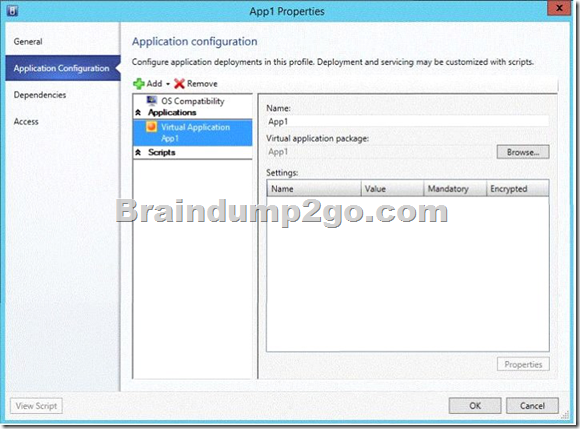
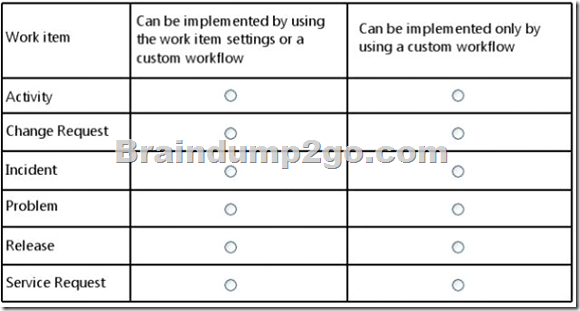
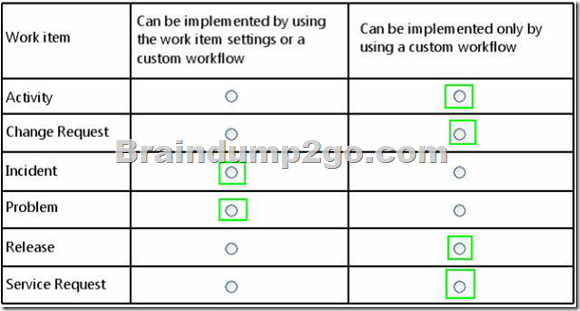
![wpsC2A4.tmp_thumb[2] wpsC2A4.tmp_thumb[2]](http://examgod.com/bdimages/dd6c4158cea8_9A38/wpsC2A4.tmp_thumb2_thumb.png)
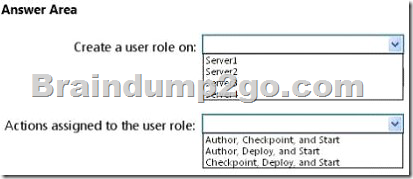
![wpsD912.tmp_thumb[1] wpsD912.tmp_thumb[1]](http://examgod.com/bdimages/dd6c4158cea8_9A38/wpsD912.tmp_thumb1_thumb.png)
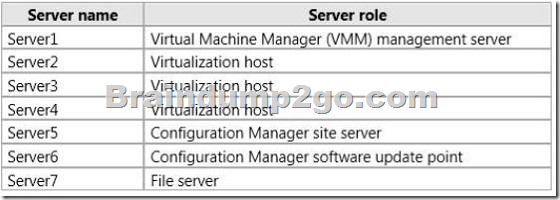

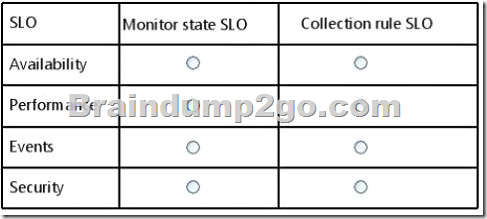
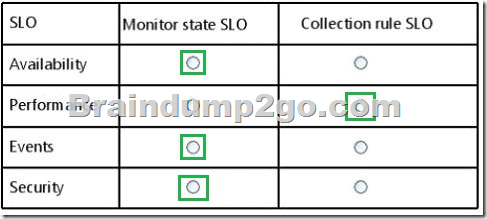
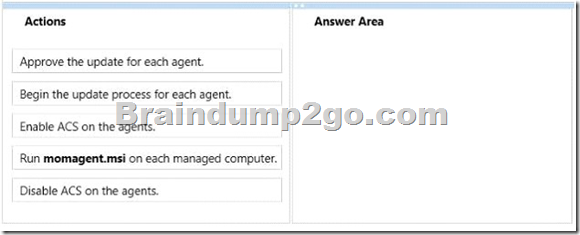
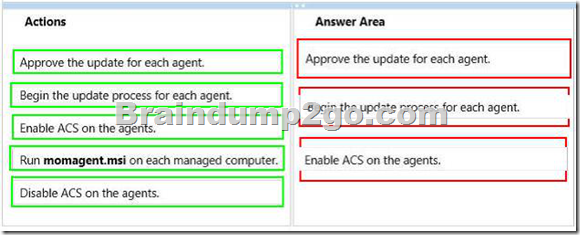

Comments are currently closed.